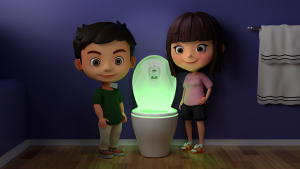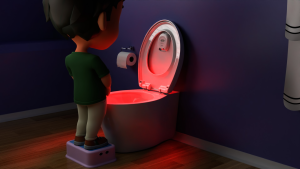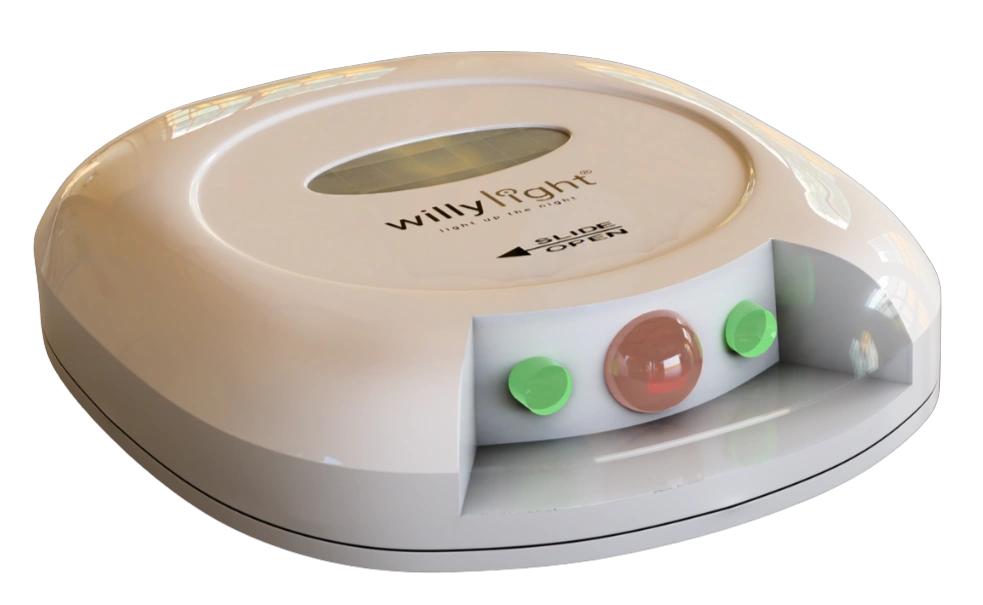Successful toilet training isn’t about finding one perfect method – it’s about matching your approach to your child’s developmental stage. When you combine age-appropriate expectations with visual aids designed for your child’s current abilities, toilet training becomes a natural progression rather than a stressful ordeal.
The most effective visual aids grow with your child – from simple color recognition at age 2 to sophisticated responsibility systems at age 4. Tools like the Willy Light work across all developmental stages because they provide the clear, immediate visual feedback that makes learning stick, while teaching important life skills like bathroom etiquette and consideration for others.
This guide breaks down exactly what to expect and which visual strategies work best for each age group, helping you choose the right approach for your child’s current developmental stage.

One of the biggest mistakes parents make in toilet training is using the same approach for every age. A 2-year-old’s brain works completely differently from a 4-year-old’s, and your toilet training strategy should reflect these developmental differences. The key to success? Age-appropriate expectations combined with visual aids that match your child’s developmental stage.
Understanding what’s realistic for each age – and using the right visual tools – transforms toilet training from a frustrating battle into a smooth, successful journey.
Why Age-Appropriate Expectations Matter
Every child develops at their own pace, but there are predictable patterns in how toddlers learn toilet skills. Expecting a 2-year-old to master complex bathroom etiquette sets everyone up for failure, while underestimating a 4-year-old’s capabilities can slow progress unnecessarily.
The secret is matching your approach – especially your visual aids and expectations – to your child’s current developmental stage, not their chronological age or your timeline.
Ages 2-2.5: Foundation Building with Simple Visual Cues
At this stage, your toddler’s brain is just beginning to connect physical sensations with actions. They’re learning cause and effect, but complex rules are still beyond their grasp.
Age-Appropriate Expectations:
- Sitting on the potty for 2-3 minutes (clothed or unclothed)
- Beginning to associate the bathroom with elimination
- Understanding basic bathroom vocabulary
- Following simple, one-step instructions
Visual Aids That Work:
Simple picture schedules work best at this age. Create a basic visual sequence: diaper off → sit on potty → diaper on. Use real photos of your child or simple drawings.
Color-coded systems help with routine recognition. Use the same colored cup for bathroom trips, or place a special colored mat in front of the potty.
Timer with visual countdown makes waiting time concrete. Many 2-year-olds respond well to sand timers they can watch.
The key principle: Keep visual aids simple and concrete. Abstract concepts like “good behavior charts” are too advanced and will only frustrate both of you.
Common Mistakes to Avoid:
- Expecting consistent success
- Using complex reward charts
- Focusing on technique over routine
- Rushing the process when accidents happen
Ages 2.5-3: Active Learning with Interactive Visual Tools
This is typically the sweet spot for active toilet training. Your child’s language skills are expanding rapidly, and they can understand multi-step processes.
Age-Appropriate Expectations:
- Communicating bathroom needs (though not always in time)
- Following a 3-4 step bathroom routine
- Beginning to undress independently
- Understanding “before” and “after” concepts
- Staying dry for 2-3 hour periods
Visual Aids That Excel:
Progress charts with immediate rewards become effective now. Use sticker charts, but make rewards immediate and tangible – a special sticker or small toy after each success.
Step-by-step visual guides posted at child’s eye level near the toilet. Include: pull down pants → sit on potty → wipe → flush → wash hands. Visual cues like these transform the learning process by making each step clear and memorable.
“Bathroom helper” visuals work wonderfully. Create a visual reminder about proper toilet seat etiquette – even at this young age, children can learn to check the seat position.
Success celebration visuals help maintain motivation. Take photos of your child’s successful bathroom trips to create a “big kid” photo book they can look at proudly.
Advanced Visual Tools:
Consider investing in visual reminder systems that make bathroom routines automatic. Tools that provide clear visual cues help establish habits that stick long-term.
Ages 3-4: Mastery and Independence with Detailed Visual Systems
At this stage, your child can handle more complex visual systems and has the cognitive ability to understand rules and consequences.
Age-Appropriate Expectations:
- Complete daytime independence (with occasional reminders)
- Proper hygiene habits including thorough handwashing
- Understanding bathroom privacy and etiquette
- Managing clothing independently
- Using public restrooms with guidance
Visual Aids for Mastery:
Detailed bathroom etiquette charts become appropriate now. For boys especially, visual reminders about proper toilet seat management and bathroom courtesy help establish lifelong good habits.
Problem-solving visual guides help with common challenges. Create simple visual flowcharts: “What to do if the bathroom is occupied” or “Steps for using a public restroom.”
Independence checklists with pictures help children self-monitor. Include items like: underwear clean and dry, hands washed, toilet flushed, seat down (for boys).
Social story visuals can address bathroom anxiety or resistance. Create a simple photo story showing your child successfully using different bathrooms.
Ages 4+: Advanced Skills and Consistency
If your child is just starting toilet training at 4, don’t worry. Late starters often master skills more quickly because of their advanced cognitive development. However, they may also have stronger resistance to change.
Age-Appropriate Expectations:
- Complete independence including nighttime training
- Understanding of bathroom etiquette in various settings
- Ability to problem-solve bathroom challenges
- Responsibility for their own hygiene and cleanup
Sophisticated Visual Systems:
Responsibility charts that track not just use, but cleanliness and consideration for others.
Problem-solving flowcharts for complex situations like dealing with public restrooms or bathroom emergencies.
Habit-tracking visuals that help maintain consistency across different environments (home, school, grandparents’ house).
Matching Visual Aids to Learning Styles
Not every child responds to the same visual approaches. Observe how your child learns best:
Visual processors respond well to detailed charts, step-by-step pictures, and color-coding systems.
Kinesthetic learners need hands-on visual aids they can manipulate – moveable picture schedules, 3D models, or interactive charts.
Auditory processors benefit from visual aids paired with songs, rhymes, or verbal cues.
Common Visual Aid Mistakes by Age
Ages 2-2.5: Using complex charts with multiple steps or delayed rewards Ages 2.5-3: Expecting perfection or using abstract concepts Ages 3-4: Underestimating their ability to handle detailed systems Ages 4+: Not involving them in creating their own visual systems
Creating Effective Visual Aids
The best visual aids share these characteristics regardless of age:
Positioned at child’s eye level – they can’t follow what they can’t see easily Use real photos when possible – children connect better with realistic images Updated regularly – keep them fresh and relevant to current challenges Child-involved creation – let older children help design their own systems
Building on Success: The Long-Term View
Remember that toilet training success isn’t just about achieving independence – it’s about building positive habits and attitudes. The visual aids and age-appropriate expectations you use now are teaching your child:
- How to follow multi-step processes
- The importance of personal hygiene
- Consideration for others in shared spaces
- Problem-solving skills for new situations
These lessons extend far beyond the bathroom and contribute to overall maturity and independence. When children learn proper bathroom etiquette early, it prevents the family conflicts and battles that often develop when these habits aren’t established during the toilet training phase.
Troubleshooting by Age
Ages 2-2.5: If progress stalls, simplify your visual aids even further and extend your timeline.
Ages 2.5-3: Resistance often means your expectations are too advanced. Scale back and focus on one skill at a time.
Ages 3-4: Power struggles at this age often respond well to giving children more control over their visual tracking systems.
Ages 4+: If a 4-year-old is struggling, rule out medical issues first, then consider whether anxiety or perfectionism is interfering with progress.
Conclusion: Right Approach, Right Age, Right Results
Successful toilet training isn’t about finding the one perfect method – it’s about matching your approach to your child’s developmental stage. When you combine age-appropriate expectations with visual aids designed for your child’s current abilities, toilet training becomes a natural progression rather than a stressful ordeal.

The most effective visual aids grow with your child – from simple color recognition at age 2 to sophisticated responsibility systems at age 4. Tools like the Willy Light work across all developmental stages because they provide the clear, immediate visual feedback that makes learning stick, while teaching important life skills like bathroom etiquette and consideration for others.
Remember: a 2-year-old who masters sitting on the potty consistently is achieving just as much success as a 4-year-old who manages complete independence. Meet your child where they are, use visual tools that match their developmental stage, and celebrate every step forward.
The right approach for the right age, supported by effective visual aids, sets the foundation for lifelong bathroom independence and confidence.
For more specific guidance, explore our related articles on teaching toilet seat etiquette, how visual cues transform toilet training, special considerations for boys, and supporting late starters who need extra help.




